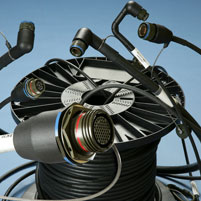You are in: Blog

EMC considerations for wiring harness design
Designing and manufacturing multi-core wiring harnesses that meet the exacting standards required for EMC and TEMPEST is an extremely challenging task.
Through experience gained over the years Tekdata Interconnections has become an expert in achieving the highest standards in screened harness assembly.
This piece describes some of the challenges in achieving EMC compliance in wiring harnesses and proposes a “Common Approach” to reducing risk during the early development phases of a program.
Standard Screened backshell & Boot assemblies
Typical Tekdata low profile screened & moulded assemblies
Question: What are the considerations for EMC?
Answer 1:
For single core co-axial cable - It’s Complicated!
Answer 2:
For complex multi-core cable – It’s Very Complicated!!
Answer 3:
For multi-core, multi-leg cable assemblies – It’s extremely complicated
(More than 80% of all system generated EMC failures will propagate onto and manifest themselves on the harnesses).
The performance of any given Cable is determined by its Design and Construction
Performance of the Harness is Directly Related to the Construction andWorkmanship
Cable Construction is Determined at the Development Stage
Workmanship is Controlled through Training and Robust Processes and Procedures
Tekdata Supply both “Design-to-Specification” & “Build-to-Print”Harnesses
Testing to EMC & TEMPEST Levels are Normally Done at System Level, i.e. – when the whole assembly is completed
This leads to the harnesses becoming a High-Risk element of the whole system
In order to reduce this risk, Tekdata recommend the following Common Approach as part of an overall Risk Mitigation Plan;
Selection of the best materials with proven RFI performance
Testing of Cables as soon as they become available in order to characterise them.
Building and testing of Harness Test Articles during the Development Stage
Subsequent Control of Processes during the Manufacturing Stages will ensure repeatability of performance for all subsequent builds.
Due to mechanical, signal, and RFI requirements, each application is unique. Having a standardised, Common Approach, to the problem however, reduces risk whilst also increasing overall levels of performance from the wiring harnesses and subsequently, the overall system.
If you require more information or wish to discuss the content of this article in more detail, please do not hesitate to contact Terry McManus at Terry.McManus@tekdata-interconnect.com.
Article first published : 8/8/2014